

Using Windows 11
Understanding the key differences as we move to Windows 11, including training, storage (OneDrive, K and N drives), the VPN, and more.
Welcome to Windows 11
Windows 11 is the latest operating system from Microsoft, designed to deliver a modern, streamlined user experience with enhanced performance, security, and productivity features tailored for today’s hybrid work environment. For more information about the rollout please see the Windows 11 Project Page on the Modern Work Programme Information site.
Information on this article is under review and may change.
Preparing for your upgrade to Windows 11
This section contains guidance on your upgrade to Windows 11
Essential information for Windows 11 users
Colleagues should be aware of the following:
- Storage: While you will have access to OneDrive to store personal work-related files, Google Drive remains your primary storage platform.
- Microsoft Office upgrade: The Office version installed on your current Windows 10 device will be upgraded from Office 2019 to Office 365. This automatically syncs with the same office tools provided by Office 365 for the web meaning your work is accessible from anywhere via a web browser.
- Microsoft Office Compatibility issues: Please see the 'Microsoft Office Compatibility Issues section below'.
If you have any questions about the above, please email digitalskills@port.ac.uk
Key differences from Windows 10 to Windows 11
Below are the main differences between Windows 10 and 11
- OneDrive will be the default location for file storage (15gb limit), Google Drive will still be available via your browser
- Microsoft Edge will be your default browser
- Redesigned user interface, the start button is now positioned in the centre of the screen
- Company Portal replaces Software Centre
- Office 365 will replace Office 2019
- Apps Anywhere will be available from your system tray
- Copilot Chat is available to install from the Company Portal
- System upgrades will now occur automatically
- Windows Store will be unavailable in Windows 11. Instead you can download apps from the Company Portal or Apps Anywhere . This ensures that all applications are secure, compliant and tailored to our organisational needs.
OneDrive
Microsoft OneDrive is directly built into Windows 11 and set as the default place to save your personal files. At the University, we recommend using OneDrive as your main storage for work-related documents to keep them safe, backed up, and easy to access across your devices.
Please note the following:
- OneDrive is for personal file storage. Use it to store and manage your own documents. This keeps your files backed up and accessible across devices.
- Google Drive remains available for shared drives. Continue using Google Shared Drives for team or departmental collaboration until further notice.
- Because OneDrive is integrated into Windows 11, some applications may save files there by default. We recommend checking your OneDrive folder regularly to review what has been saved.
OneDrive is the University’s primary storage solution as part of the Modern Work Programme. Further guidance and support can be found in the Working with OneDrive article.
Compatibility issues with Office 2019 and Office 365
- There have been a few reported incidents of content loss when sharing Microsoft Office documents between Office 2019 on a desktop and Microsoft documents created in a browser using Office 365 for the web. This is a known Microsoft issue.
- Office 2019 is currently on standard UoP Windows 10 devices, Office 365 will be installed on Windows 11 devices, while Office 365 for the web is available via any browser via office.com
- Be mindful when collaborating with colleagues who are not yet upgraded to Windows 11 that there are known compatibility issues between Office 365 for the web and Office 2019 which can result in data loss when collaborating. To avoid this, current guidance is to continue to use Google Workspace for collaboration and document sharing until notified otherwise.
Windows 11 support
If you require any support with Windows 11 after your upgrade please contact Service Desk. The Contact IT Support article contains detailed information on how to reach the Service Desk.
Preparing for Windows 11
Digital declutter
Before upgrading to Windows 11, please schedule some time to complete a digital declutter.
A digital declutter involves removing Redundant, Obsolete and Trivial (ROT) digital items. This will help to enhance efficiency, compliance and minimise data storage requirements.
For detailed guidance please refer to the digital declutter and the Corporate Governance Information Matters articles.
Transfer files saved on your Desktop or in your Download Folder
The Windows 11 upgrade will delete any files stored directly on your device on your Windows 10 device this includes:
- files saved on your Desktop
- files saved in your Downloads folder
- files saved in your Documents folder
If you need to keep these files, you will need to move them to either your Google Drive or N: Drive before upgrading.
Note: Your Google Drive and N: Drive will not be affected by the upgrade.
Instructions
- Open File Explorer and display your Download folder (This PC > Documents > Downloads > Chrome Downloads)
- Drag any files you need to keep to your N: Drive or Google Drive
- Open File Explorer and display your Desktop folder (This PC > Desktop)
- Drag and files you need to keep to your N: Drive or Google Drive
The recommended browser for Windows 11 is Microsoft Edge.
The process to transfer your bookmarks is simple and consists of the following steps:
-
Complete housekeeping in Google Chrome: Review and delete any unnecessary bookmarks. This will streamline the import process, enhance browser performance, and ensure a more organised bookmark collection.
- Sign into Google Chrome and enable sync: This will allow you to transfer your bookmarks seamlessley into Google Chrome
Complete Housekeeping on your Bookmarks in Chrome
- Open Google Chrome
- Click on the ... at the top right of your browser a menu will display
- Select Bookmarks and lists and then Bookmark manager
- The Bookmark manager click on a folder to display the bookmarks
- To delete a bookmark select the ... after the bookmark, a menu will display select Delete
- To delete a folder right click on the folder and select delete
- To create a new folder select the ... next to the search bar and select Add New Folder
(The Video below also contains a demonstration on housekeeping your bookmarks)
Sign into Google Chrome and ensure Sync is enabled
- Open Google Chrome
- Click on the profile disc (top right)
- A dialogue box will display, if you are not signed on the Sign in Button
- Use your University email and password to sign in
- Clicking on the profile disc, will now show that you are signed in and that Sync is on
NB: Google Chrome is available to download from the Company Portal
Note: Ensuring sync is on in Chrome will allow you to import bookmarks, passwords, and browsing history into Microsoft Edge.
- Please make a note of any Apps Anywhere apps you use, as these will need to be installed in Windows 11.
- Sticky Notes is a Windows 10 feature that allows you to create virtual sticky notes that are displayed on your desktop
- Any sticky notes you have created will be lost when you upgrade to Windows 11
- Please record any information you need in a document and store it in a file in Google Drive or on the N Drive
There are several versions of OneNote, and file locations may vary based on how the notebook was set up. Follow the instructions below to ensure any OneNote files are saved correctly before upgrading to Windows 11.
OneNote on the web
No action needed as these notebooks are stored in OneDrive. They will remain accessible once you have upgraded to Windows 11.
OneNote for Windows 10
Notebooks are automatically synced to your Microsoft 365 account and are not stored locally. These will be available on OneNote for the Web, or when you sign into OneNote on your Windows 11 device.
To check:
- Open OneNote for Windows 10 from your start menu
- Click on Settings (click on the ... top left) on the menu bar
- Select Accounts
- Ensure that you are signed into your UoP account. An example is shown below:
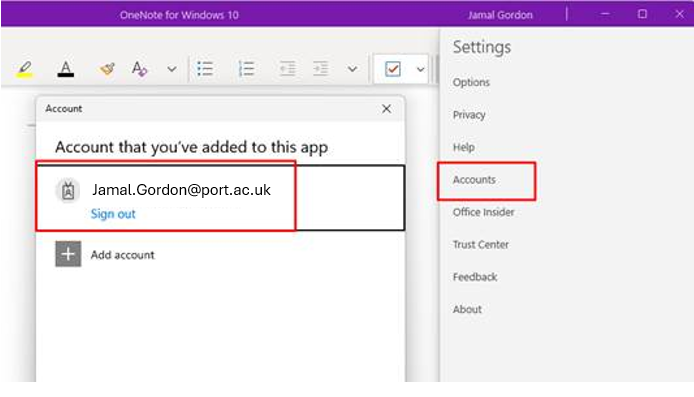
In addition check that the Sync icon is shown on OneNote, see below:
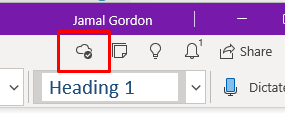
OneNote 16
OneNote 16 notebooks can be stored locally or on OneDrive. Notebooks that are stored locally will need to be synced to OneDrive. To check where your notebooks are stored follow the instructions below:
- From the start menu open OneNote 16
- Select File in the top left
- Your notebooks will be displayed showing where they are stored
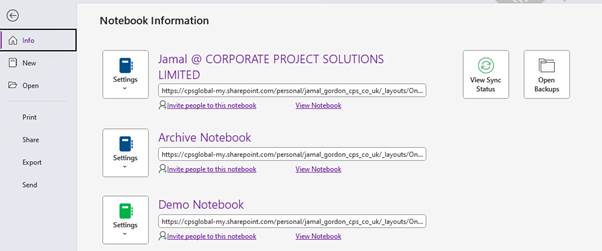
In the example above the notebooks are stored in Microsoft 365 as the path starts with https:\\. These notebooks will be available when you upgrade to Windows 11.
However, if any of your notebooks show a local file path starting with C:\ you will need to sync them to OneDrive by following the instructions below.

To sync a local notebook to OneDrive
- Log into your Microsoft 365 account by opening a browser and logging into Office.com with your university credentials
- From the start menu of your Windows 10 device open OneNote16
- Select File in the top left
- Your notebooks will be displayed showing where they are stored
- If your notebook is stored locally (you can tell because of the C:\ file path) select Share on the web or network (shown under the locally stored notebook)
- Select OneDrive followed by browse and select a OneDrive folder to store your notebook
- You will be prompted to name the notebook, click on Move
- It may take a while for your notebook to sync, to force the sync click on Settings followed by Sync
- Your notebook will now be available through the OneNote app - we recommend that you check your notebooks have moved before your device is upgraded to Windows 11.
Viewing OneNote in M365
- Open a browser
- Navigate to Office.com and log in with your university credentials
- Click on the App launcher and select OneNote
- OneNote will open showing the available notebooks
- At a designated time, laptop users will be asked to schedule an appointment for their upgrade at the W11 Upgrade Hub located on the ground floor of St. Andrews Court.
- When attending your appointment, please ensure you bring a phone (or another device) for Multi-Factor Authentication which is required for the upgrade process
Training
Discover quick and easy training options to help you feel confident using Windows 11.
Trainer-led courses
Below is a list of training that has been developed to support your transition to Windows 11:
- Windows 11 how to prepare for your upgrade and what's new
- Using Windows 11 and Microsoft Edge
- Using Copilot Chat in Windows 11
Training is offered through live trainer-led sessions or on-demand video tutorials, all accessible via Docebo the University Staff Learning Management system
Accessing Docebo
- Open a web browser.
- Navigate to Docebo.
- Select the Blue Single Sign-on button.
- Select My Learning Plans.
- Select the Modern Work Programme Learning Plan: Windows 11.
- The training options will be displayed.
- Select Enrol to access or book training.
If you need assistance finding these courses email digitalskills@port.ac.uk.
LinkedIn Learning Windows 11 training
As a member of staff you currently have access to LinkedIn Learning. For more information, view this article
Windows 11 Essential Training: This is a comprehensive course that contains chapters on:
- Getting Started with W11
- Launching and Using Applications
- File Explorer
- Working with the Desktop
- Working with Bundled Applications (including Edge)
- Using Search Tools
- Managing Notifications
- Using Accessibility Features
Windows 11 Quick Tips: Lots of quick tips to get the most of Windows 11. This course includes videos on:
- General Interface tips
- Modifying the Taskbar
- File Management
- Working with applications
How-to guides
Use the tabs below to explore key features and functionality available in Windows 11
- You now need to use your email address as your username and complete Multi-Factor Authentication (MFA) when logging in to student-facing or presentation PCs. This means you will need to have your preferred authentication device with you, such as your mobile phone or hardware token, to log in.
- For guidance on using Windows 11, including common FAQs, visit Working with Windows 11. If you need technical assistance, please contact the Service Desk.
Start menu
The Start Menu is in the centre next to the search bar. Click here to view image
To open an application:
- Click on the Start Menu
- Once opened you will see Pinned Apps
- Click on View apps to show all apps
- Select the App to open
- To Pin an app so it is visible when you click on the start menu right click the app and select Pin
Search bar
The search bar can be used for various types of searches. Here are some examples:
- Find and open an app – Type the name of an app to locate and launch it.
- Search for a file – Enter the file name or keywords from the file, then select the Document filter at the top of the search results.
- Perform an internet search – Type your query to search the web directly
Changing the location of the start menu
- Right-click on an empty space in the taskbar
- Select Taskbar settings
- Click Taskbar behaviours in the right pane
- Select the Taskbar alignment drop-down
- Change the alignment from Centre to Left
Shutdown and restart
It is always advisable to shut down Windows 11 each night after you finish work.
If it has been some time since you last properly shut down, we recommend restarting to ensure all software can be updated if needed.
- Click on the Start Button (to the left of the search bar on the task bar)
- At the bottom left of the dialogue box a power button will display, click on to display options:
- Lock
- Sleep
- Shut down
- Restart
Multiple Desktops
Task View is available on the Task Bar. View Image
Having multiple desktops allows you to separate your tasks into different places, which can be especially handy if you need to multitask.
Task View is made up of two sections. View Image
- The top allows of the screen show all the applications and browser windows you have running on a desktop. You can open a window by clicking on the thumbnail
- The Second part of the screen contains virtual desktops, click the + symbol to create a new virtual desktop.
For more information, please view this Microsoft article
File Explorer and OneDrive
- The default Home view displays recommended, favourited and recent files
- The folder signified by the blue cloud displays files stored in your OneDrive
- Mapped folders such as the N:Drive will be displayed under Network
Note: All files and folders placed in OneDrive will automatically sync to the web version
Snap layouts
Snap layouts are preconfigured ways to organise windows on your screen
- Hover over the minimise or maximise button in the upper-right corner of your window to launch the Snap layout box
- Select the layout you wish to use
For more information view Windows 11 Snapping article
Themes
A theme is a combination of desktop background pictures, window colours, and sounds.
- Click on the Start button
- Click on Settings
- Select Personalisation
- Select Themes
- In the Current Theme section, choose a theme to select it
- Close the Screen
Accessibility in Windows 11
To access the accessibility options:
- Click on the Start Menu
- Click on Settings
- Select Accessibility in the panel on the left
- Accessibility Options will display
Accessibility Options are listed in three categories:
Vision
- Text Size
- Visual Effects (Scroll bars, transparency, etc)
- Mouse Pointer and Touch
- Text Cursor
- Magnifier
- Colour filters
- Contrast themes
- Narrator: This is a screen reader
Hearing
- Audio
- Captions (option to turn Audio and Video Captions live on your screen)
Interaction
- Speech (Allows you to control your device via voice)
- Keyboard
- Mouse
- Eye Control
For more information, please view the Microsoft Accessibility in Windows 11 article
Microsoft Edge
After upgrading to Windows 11, we recommend using Microsoft Edge as your browser. Microsoft Edge offers many benefits, including:
- Seamless integration with Microsoft products for a smooth user experience.
- Productivity-enhancing features such as Collections, screenshot tools, advanced search and Copilot Chat.
- Customization options like vertical tabs for a personalised browsing experience.
- Chromium-based foundation for compatibility with a wide range of websites and services
For more information, please view the Microsoft Edge article.
Deleting files: OneDrive & Windows 11 recycle bins
The default storage location for files you create using a Windows 11 device is Microsoft OneDrive. Staff are currently allocated 10gb to store files.
Using File Explorer to access your OneDrive
- Open File Explorer (yellow folder on your task bar)
- Click on your OneDrive Folder in the navigation pane - it will have a blue cloud icon with your name next to it
- Your OneDrive files and folders will be displayed
- To delete a file, hover over the file, right click and select the Delete Icon
- When you open a file from File Explorer it will be synced to your device, the Status column will indicate where the file is synced to:
- A green tick in a circle indicates the documents has been synced to your device – the file will be available on your device and in the cloud via office.com
- A blue cloud icon next to the file or folders indicates the file has not been synced to your device
Accessing OneDrive via a browser
- Open a browser and navigate to Office.com, if prompted to sign in, select OneDrive from the app launcher
- Select My Files in the navigation pane, your files and folders will display (the default home view is automatically generated and does not give full functionality)
- To delete a file or folder hover over it, right-click and choose Delete
- To open a file hover over it, right click and select Open, you will have the choice to Open in a browser Open in app
Recycle Bins
There are two recycle bins:
OneDrive Recycle Bin
To access the Recycle Bin log into OneDrive via a browser, click on Recycle bin in the navigation panel.
The following files will move to this Recycle Bin when deleted:
- Files that have been created and edited in the browser
- Files that have been synced to your device*
*These files will also go to the Windows 11 recycle bin.
Files will remain in the OneDrive Recycle Bin for 93 days. If you delete them from the OneDrive Recycle Bin before 93 days, they will move to the second stage Recycle Bin, which acts as a fail-safe. They will remain there for the remainder of the 93 days unless you delete them permanently.
Windows 11 Recycle Bin
To access the Recycle Bin, click on the Icon on your desktop.
The following files will move to the Recycle Bin when deleted:
- Files that are synced to your device*
- Any other files are stored locally e.g. files in your Download folder
*These files will also go to the OneDrive Recycle bin.
Locally deleted files will remain here until you empty it. OneDrive files will be deleted after 93 days.
Syncing
Syncing means that specified folders on your W11 device are automatically updated to OneDrive in the cloud. This allows you to access to these files via an internet browser through Office.com or mobile app. When you add, change, or delete a file in your synced folder, these changes are reflected both locally and in the cloud.
Your Windows 11 device will be set up to automatically sync folders to OneDrive:
- Desktop
- Documents
- Pictures
Choosing folders to sync
- Select OneDrive icon in your task bar
- Select the Cog
- Select Settings
- Select Account
- Click on the Choose folders button
- The Choose Folders screen will display, folders that are greyed out will automatically be synced. You can select or deselect folders to sync by clicking on the check box next to the folder
Installing apps in Company Portal
Company Portal
Company Portal allows you to securely install applications such as Copilot Chat, VPN and Adobe. In Windows 11 the Company Portal replaces the Software Centre.
Installing applications
- Click on the Company portal icon on your desk desktop
- The Company Portal will open
- In the Navigation panel on the left select Applications
- The apps available to install will be displayed, click the app you want to install
- More information will be displayed along with an Install button, click on the Install button
- The app will be installed this may take several minutes, an Installed message will display once completed
- The app will now be available from your Start menu.
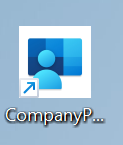
Installing the VPN

- Open Company Portal; there is a shortcut on your desktop (see image above)
- Select Apps in the left-hand menu
- Click on Global Protect VPN Staff
- More information about the app will display, click on the Install button
- The app will install, this may take several minutes, an Installed message will display once completed
- The VPN will now be available from your System tray (it's in the same location as it was in Windows 10)
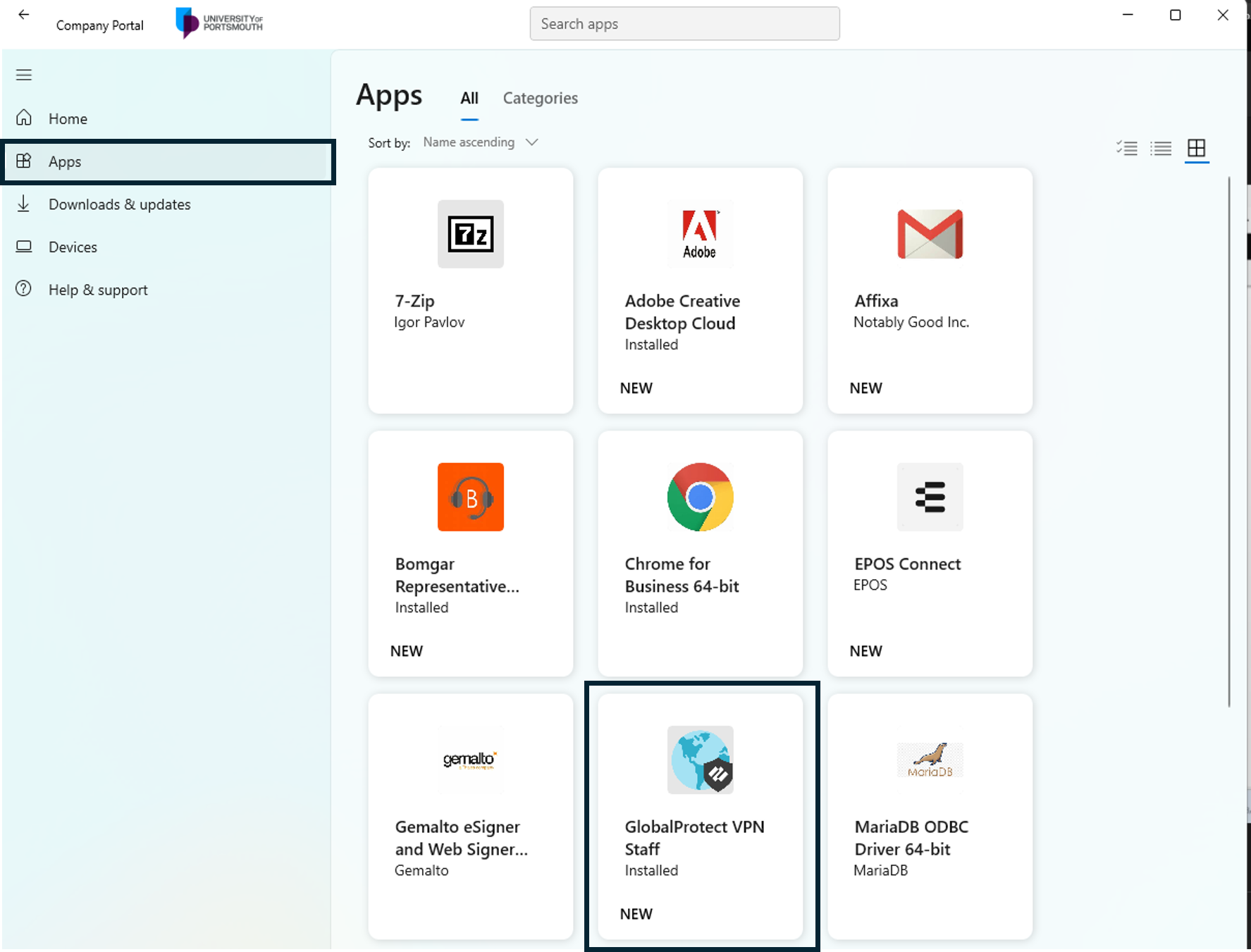
Installing Chrome
Note: Microsoft Edge is the recommended browser for Windows 11.
Microsoft Edge is purpose-built for Windows 11 and Microsoft 365, offering advanced features and tools to optimise your experience.
Google Chrome however is available form the Company Portal.
- Open Company Portal; there is a shortcut on your desktop
- Select Apps in the left-hand menu
- Click on Chrome for Business
- More information about the app will display, click on the Install button
- The app will install, this may take several minutes, an Installed message will display once completed
- At the end of the process you will get a message asking if you want to set Chrome as the default browser (you can also do this later see instructions below)
- Chrome will now be available from your Start Menu
Setting Chrome as a default browser
- Click on the Start button
- Select Settings
- In the search bar at the top of the navigation panel on the left type default apps
- Select Default Apps from the search results
- In the second search bar Set defaults for applications type in Chrome
- The Apps > Default apps> Google Chrome page will open. Make Google Chrome your default browser will appear at the top of the page click on the Set default button
Windows 11 FAQs
Below are answers to commonly asked Windows 11 questions
The Google Drive for desktop app allows users to access their Google Drive as a G Drive in File Explorer.
However, during testing for Windows 11, the app encountered file syncing errors. Consequently, the project team have decided not to make this tool available. You can however still access Google Drive via your web browser.
Mapping the N drive to File Explorer
Step 1: Connect to the VPN.
- Connect to the VPN if you are off site.
Step 2: Locate and copy your N drive path
-
Click on the following link to find your N drive location.
- A search screen will display type in your username e.g. selwaya and click on the search icon.
- A screen will display. In the N Drive column select and copy the Windows path.
Step 3
Choose to create a temporary or permanent connection to the N Drive.
Option 1: Temporary Connection: This method will disconnect when you log off.
- Type Run the search bar and press enter on your keyboard
- In the open field, enter: <your N drive location> and click on OK
- The N drive will now be available under This PC in File Explorer (it may take several minutes to appear
Option 2: Permanent connection.
- Open file explorer
- Scroll down and right-click on This PC
- Select Map network drive
- In the Drive dropdown field, select N
- In the Folder field, paste: <your N drive location>
- Ensure you tick Reconnect at sign-in
- Click on Finish
- Your N Drive will appear under This PC in File Explorer (it may take several minutes to appear)
Mapping the K drive to File Explorer
NB: you will need to connect to the VPN if you are off-site
Option 1: direct connection
This method will disconnect when you log off
- Connect to the VPN if off-site
- In the search bar, type run and press enter on your keyboard
- A run dialogue box will appear
- Type in \\sp1\public
- Click on OK
- Click on Finish, and you will now have the K Drive Available under This PC in File Explorer (it may take several minutes to appear)
Option 2: permanent connection
- Connect to the VPN if off-site
- Open File Explorer
- Scroll down and right-click on This PC
- Select Map network drive from the ... See more menu
- Select the Drive Letter K
- Click in the folder box
- Type in \\sp1\public
- Click on Finish
- Your K Drive will now appear under This PC in File Explorer (it may take several minutes to appear)
Connecting to the VPN
The process of connecting to the VPN remains the same in Windows 11.
- Click on the up arrow in the system tray. View Image
- Select the Global Protect Icon View Image View Image
- The Global Protect dialogue box will display Click on Connect View Image
- Type your credentials in the SSO
- You may be asked to authenticate
- A message will appear informing you that "The site is trying to open GlobalProtect", click on Open View Image
- GlobalProtect will connect and the icon will change to blue.
Accessing Wi-Fi on Windows 11
- Click on the Wi-FI icon which is located to far right side of the task bar View Image
- Select the Wi-Fi Quick setting, followed by the down arrow
- Select the Wi-Fi you wish to connect to
Downloading the Zoom Client
- If you are off-site turn on the VPN
- On your desktop, click on the Company Portal Icon
- The Company Portal will open; click on the Zoom icon to select it. View image
- Click on Install, the installation may take a few moments. View Image
- You will be notified when Zoom is installed. View Image
- Close Company Portal
- Zoom will now be available via the start menu, alternatively, type in Zoom in the search bar
- Select Sign in to Zoom
- Select sign-in with SSO View Image
- Fill in the SSO username and password
- You may be asked for authentication
- Zoom should open
Opening Zoom automatically when starting your computer
- If you want Zoom to open automatically when start your computer
- Click on your Profile Icon in Zoom View Image
- Select Settings
- In the General category, select Start Zoom when I start Windows View Image
Changing the location of the start button
- Right-click on an empty space in the taskbar
- Select Taskbar settings
- Click Taskbar Behaviours in the right pane
- Select the Taskbar alignment drop-down
- Change the alignment from Centre to Left
Turn on dark mode
- Using the search bar at the bottom of the screen, search for the settings
- Settings (with a cog) will appear as a Best Match
- Select Personalisation from the left menu
- Select Colours
- In the Choose Your Mode section, select Dark from the drop-down menu
Adding a printer at home
- Select the Start button
- Select Settings (ensure the window is opened fully)
- Select Bluetooth & devices
- Select Printers and Scanners
- Select Add Device
- Available printers will be displayed
For more information, please view the Add a Printer article
Adding a bluetooth device
- Turn on your Bluetooth device and make it discoverable. The way you make it discoverable depends on the device. Check the device or visit the manufacturer's website to learn how.
- On your PC, select the Network, Sound, or Battery icons ( ) next to the time and date on the right side of your taskbar.
- Select Manage Bluetooth devices on the Bluetooth quick setting, then select your device under New Devices. View image
-
Follow additional instructions if they appear, then select Done.
-
Your Bluetooth device and PC will usually automatically connect anytime the two devices are in range of each other with Bluetooth turned on.
For more information, please view the Pair a Bluetooth Device article
Using USB memory sticks
When you plug in a USB stick/drive, you will get a message informing you:
- You will need to Encrypt the drive using BitLocker Drive Encryption
- Don't encrypt this drive. If you choose this option, you will be able to open files on the drive but you will not be able to save new files on it.
Encrypting your USB Stick/drive
- Choose Encrypt the drive using BitLocker Drive Encryption View image
- Select Use a Password to unlock this device View image
- Type in a Password and Re-enter. Click on Next
- Choose How you want to unlock this device screen will display, select Use Password View Image
- You will then be prompted to create a backup for your recovery key. Choose Print the Recovery File (Save to a file does not work as your laptop is already encrypted.) View Image
- In the next screen, you can select a printer to print your recovery file. If you choose Adobe PDF, you will be able to save the file to your laptop.
- You will then be prompted to start encrypting your drive. Please be aware encrypting a device may take several hours.
What to expect after encrypting your USB drive
Once your USB stick or drive has been encrypted with BitLocker, there are a few things to keep in mind when you use it in the future:
- You will be prompted to enter the password you created each time you plug the drive in.
- If you do not enter the password, the drive will open in read-only mode and you will not be able to save or edit files.
- If you forget your password, you can unlock the drive using the recovery key you created when you first set up BitLocker.
- Make sure your password is memorable and easy for you to enter, while still being secure.
Note: Encrypted USB drives are useful for transport, but important or long-term documents should ideally be stored in a more resilient location such as OneDrive.
Printing on site
Note: Make sure you are connected to the VPN to view the printer options.
- At the bottom-right of your screen, select the small arrow (^) to open the system tray.
- Select the green printer icon labelled PaperCut Print Deploy Client.
- Choose View my printers.
- Check that the staff printer appears as: \\printing-app-02\UoP-Printer
- If the printer is missing, check for any Windows updates, install them if available, and restart your device.
- If the printer still does not appear after updating and restarting, please contact the Service Desk.
- Open OneDrive in a browser
- Select Settings Cog
- Select OneDrive Settings
- The Notification Settings Panel will display
- Use the Toggle button to turn specified notification on or off






